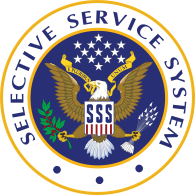 | |
| Agency overview | |
|---|---|
| Formed | 18 May 1917 |
| Employees | (2017): 124 full-time civilians, 56 part-time civilian directors, 175 part-time reserve force officers (in peacetime), up to 11,000 part-time volunteers[1] |
| Annual budget | $31.3 million (FY 2024) |
| Agency executive |
|
| Website | www |
The Selective Service System (SSS) is an independent agency of the United States government that maintains a database of registered male U.S. citizens and other U.S. residents potentially subject to military conscription (i.e., the draft).
Although the U.S. military is currently an all-volunteer force, registration is still required for contingency planning and preparation for two types of draft: a general draft based on registration lists of males aged 18–25, and a special-skills draft based on professional licensing lists of workers in specified health care occupations. In the event of either type of draft, the Selective Service System would send out induction notices, adjudicate claims for deferments or exemptions, and assign draftees classified as conscientious objectors to alternative service work.[2]
All male U.S. citizens and immigrant non-citizens who are between the ages of 18 and 25 are required by law to have registered within 30 days of their 18th birthdays,[3][4][5] and must notify the Selective Service within ten days of any changes to any of the information they provided on their registration cards, such as a change of address.[6] The Selective Service System is a contingency mechanism for the possibility that conscription becomes necessary.
Registration with Selective Service may be required for various federal programs and benefits, including job training, federal employment, and naturalization.[7]
The Selective Service System provides the names of all registrants to the Joint Advertising Marketing Research & Studies (JAMRS) program for inclusion in the JAMRS Consolidated Recruitment Database. The names are distributed to the Services for recruiting purposes on a quarterly basis.[8]
Regulations are codified at Title 32 of the Code of Federal Regulations, Chapter XVI.[9]
- ^ "Quick Facts and Figures". US Selective Service System. Archived from the original on 20 January 2020.
- ^ "What is the Selective Service System?stem". Resisters.info. Retrieved 13 February 2021.
- ^ Who must register?, When to enlist Archived 29 April 2015 at the Wayback Machine, Selective Service System.
- ^ "Selective Service System > Home". www.sss.gov. Archived from the original on 1 June 2015. Retrieved 9 February 2012.
- ^ Selected Service System. Who Needs to Register. https://www.sss.gov/register/who-needs-to-register/.
- ^ "Change of Information". Selective Service System. Retrieved 13 October 2015.
- ^ Benefits and Programs Linked to Registration Archived 27 July 2008 at the Wayback Machine, from the Selective Service System website
- ^ "Jamrs Affiliations". Jamrs.org. Archived from the original on 22 October 2006. Retrieved 8 April 2011.
- ^ "Title 32, Subtitle B, Chapter XVI, Code of Federal Regulations". Office of the Federal Register (OFR) and the Government Publishing Office. 1 July 2016. Retrieved 27 April 2017.